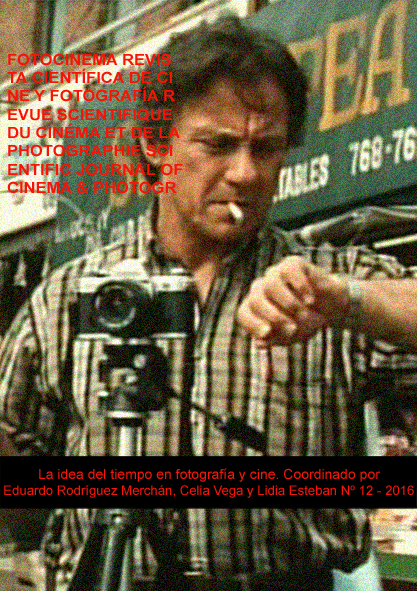Frenético, el espacio-tiempo en la fotografía artística contemporánea
DOI:
https://doi.org/10.24310/Fotocinema.2016.v0i12.6038Abstract
Este texto estudia las nuevas ideas de la física representadas en el arte.Einstein revolucionó las ciencias a principios del siglo XX; y hoy sus ideas sobre el espacio-tiempo se han asentado y confirmado en el día a día.
Las relaciones entre el entorno urbano y global con sus habitantes responden a esas nuevas formas de entender el espacio-tiempo.
El estado natural de todo cuerpo es el movimiento y en el espacio-tiempo curvo en el que nos encontramos no pueden separarse el marco de las figuras. Para esas ideas la fotografía artística contemporánea propone novedosas maneras de dibujar la imagen fotográfica: fórmulas alejadas de la óptica cónica, el ojo único, la vista completa enfocada… sin dejar de responder a la figuración y la toma directa. Fórmulas que representan las relaciones y sensaciones de los habitantes del entorno actual.
Abstract:
This essay reflects on the new ideas of physics that are represented in art.
Einstein shook up Science in the early Twentieth century; nowadays, his ideas about space-time have settled and are confirmed on a daily basis.
The relationship between the urban setting and its inhabitants respond to those new forms of understanding space-time.
The natural condition of all bodies is that of movement, and in the curved space-time we live in it is not possible to separate the frame from the figures.
In relation to those ideas, contemporary artistic photography proposes new ways of depicting a photographic image: methods that are far apart from a conic projection from camera lens, the singular point of view, everything under focus… without moving away from the figurative image and the direct shoot. These formulas represent relations and perceptions of the inhabitants of our present environment.
Palabras clave:Espacio-tiempo; paisaje; fotografía; movimiento; dinámico; entorno urbano.
Keywords:
Space-time; Landscape; Photography; Movement; Dynamic; Urban Envoiremen.Downloads
Metrics
Publication Facts
Reviewer profiles N/A
Author statements
Indexed in
-
—
- Academic society
- N/A
- Publisher
- Universidad de Málaga
Downloads
Published
How to Cite
Issue
Section
License
All contents published in Fotocinema Revista científica de cine y fotografía are protected under the Creative Commons Attribution-NonCommercial-ShareAlike 4.0 International (CC BY-NC-SA 4.0) license. All about this license is available in the following link: <http://creativecommons.org/licenses/by-nc-sa/4.0>
Users can copy, use, redistribute, share and exhibit publicly as long as:
- The original source and authorship of the material are cited (Journal, Publisher and URL of the work).
- It is not used for comercial purposes.
- The existence of the license and its especifications are mentioned.
There are two sets of authors’ rights: moral and property rights. Moral rights are perpetual prerogatives, unrenounceable, not-transferable, unalienable, imprescriptible and inembargable. According to authors’ rights legislation, Fotocinema. Revista científica de cine y fotografía recognizes and respects authors moral rights, as well as the ownership of property rights, which will be transferred to University of Malaga in open access. The property rights are referred to the benefits that are gained by the use or the dissemination of works. Fotocinema. Revista científica de cine y fotografía is published in an open access form and it is exclusively licenced by any means for doing or authorising distribution, dissemination, reproduction, , adaptation, translation or arrangement of works.
Authors are responsable for obtaining the necessary permission to use copyrighted images.














13.png)



